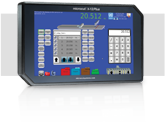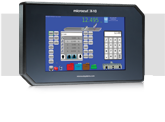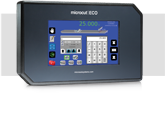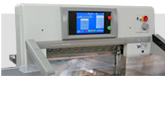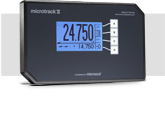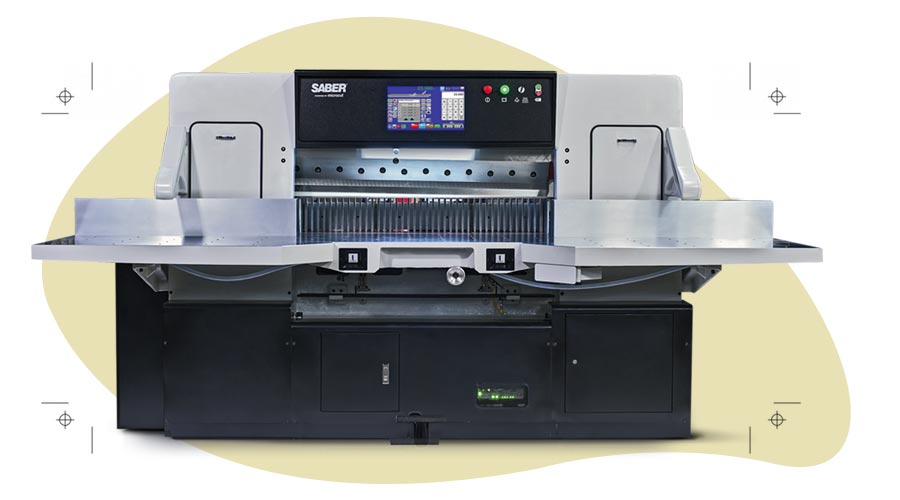The first part of this series covered basic considerations when buying a paper cutter: size of material to be cut, type of material, time you’ll spend cutting, available machine support (and parts), and finally safety features. If you haven’t read it yet, please head over to Finding The Best Industrial Paper Cutter: What You Need to Know, Part 1. It’s the best place to start.
Evaluating Industrial Paper Cutters
Guillotine paper cutters can be broken into three areas critical to evaluating a paper cutting machine. These core systems are used in every heavy duty paper cutter and are what can make the difference between a machine that lasts, and one that doesn’t.
We’ll take a look at each of these systems here.
- Mechanical design
- Control systems
- Features and loading options
Mechanical Design
When evaluating new commercial paper cutters, mechanical design is always the place to start.
As we discussed in part one of this series, all industrial paper cutters contain the same basic components—a knife, clamp, table and back gauge. While the components of all paper cutting machines are the same, how they are put together is not.
There is a tremendous amount of force in play during the operation of a guillotine cutter: the force of the knife moving down through the pile and at the same time, the force of resistance. We won’t present a detailed analysis of the physics of this force, but it’s substantial—whether you’re cutting paper, board or plastic. That why rugged design and heavy duty construction are important considerations in any paper cutter.
The simplest way to gauge the ruggedness of a paper cutter is in the weight of the machine: the heavier the paper cutting machine, the more likely it will be able to sustain the force of the cutting action. Base weight gives a paper cutter a lower center of gravity and increases the overall stability of the machine. In many instances older paper cutters are heavier than newer ones due to modern manufacturers’ need to lower costs by limiting the use of iron. Lighter metals and composite materials are often used instead. Some of the most popular 115 cm paper cutters are 1,000 pounds lighter than older machines of the same size.
The next area we recommend looking at are operating components, including the guiding systems for the paper cutter knife and back gauge.
Control Systems
The paper cutter back gauge control system moves the back gauge and displays its position relative to the cut line. The displayed size will be the size of the material after cutting.
While some smaller commercial paper cutters offer computer controls as an option, large paper cutting machines (over 36") all come with some type of computer control for the back gauge. Not all computer control systems are identical though, as the standard features they offer vary.
Basic control systems are simple digital display computers that, while limited in advanced features, do offer all the basic features needed to efficiently operate the machine and handle most paper cutting jobs.
Advanced control systems use a color display, most often with a touch screen. The nature of computer technology makes the addition of specialized features inexpensive, so most units are comparable in the features they offer.
The important factor to look at here is the ease of operation: the simpler the user interface, the easier it is to learn and use the machine. With the rapid change of computer technology, the ability to update software has become critical. This can often be accomplished through use of a USB or network connection. Most manufacturers offer software updates free of charge. Be aware that some manufactures use proprietary systems for saving jobs.
While not widely used, off line programming of a paper cutter is available and even provided standard with some control systems. Using a standard computer, a complete cutting program can be created and transferred to a paper cutting machine through use of a USB or network connection.
The ability to store programs on transferable media has become important, with the development of offline programming and the CIP 3/4 standard. The CIP 3/4 format allows information to be sent from prepress into press and finally into the bindery. Development of this standard has eliminated the restriction of data being stored on different systems and in different formats. With the standardization of date formats, information from prepress can be used to set up a paper cutter.
Colter & Peterson’s Microcut® WS computer control system with intuitive graphic interface makes programming fast and easy on any of its used, reconditioned or new SABER® and PRISM® paper cutters. Units are available with 12”, 15” and 18” color touch screens. Unlike its competitors, Microcut® systems can work with all CIP 3/4 compatible systems to convert pre-press files to cutting programs.
See our Reconditioned Paper Cutter Buying Guide: What You Should Know.
Features and Loading Options
Paper cutter features
There are three important features that come standard on paper cutting machines:
- Cutting tables
- Backgauges
- Waste disposal
Cutting tables
Modern paper cutters come with various table surface options. The long-time industry standard of cast iron is being replaced with stainless steel, nickel plated and chrome plated table surfaces. These new table surfaces, while standard on some machines, are still options on others and can often provide a superior surface for cutting. Chrome and stainless-steel tables eliminate maintenance tasks needed with cast iron (even if it is nickel plated), particularly removing rust.
Backgauges
Options exist for paper cutter back gauges. Auxiliary pieces of equipment can allow the back gauge to be swiveled and tilted. While applicable in some instances, these options need to be carefully considered as they add considerable cost to the machine and long-term maintenance fees (more motors and moving parts). They are also somewhat limited in real-world applications.
Waste disposal
Some manufactures offer a waste disposal option trade-named Automatic Waste Removal (AWR), Autotrim, or Trimmaster. With this option, the main cutter table is split at the cut line. This allows the front part of the table to move forward, opening a space for trim waste to drop through the table and into a basket, onto a waste conveyor or into a waste evacuation system.
These machines do have a limit on the size of the trim that can be dropped. It’s a great option for label work involving numerous inside trims. But for general commercial work, the extra expense may not make sense for your print shops. It is important with these trim systems to look at your waste disposal process: the basic equipment with these systems is a waste bin under the table that must be manually emptied on a regular basis.
For high volume use, a central paper waste disposal system is required. As you are often dealing with small trim pieces, a vacuum waste handling system (sometimes just called vacuum system) is the better way to go.
Loading options
There is a wide variety of auxiliary equipment or paper handling systems available to aid movement of materials on and off the paper cutting machine. The most commonly used items are oversized air tables, stack lifts and joggers.
Oversized air tables. These extended tables are mounted on the machine to increase the working table surface in front of the machine and are an integral part of creating a complete cutting system. Oversize air tables (typically 30” X 40” or 40” X 40”) allow material to be staged for cutting and give the operator space to remove cut material.
Stack lifts. Stack lifts allow operators to efficiently raise or lower material to be cut or stacked with ease. Through use of an infrared eye beam system, stack lifts automatically position the platform to an ideal working height for the operator to pick up or drop the material. Since the platform can be loaded or off-loaded with a simple pallet jack, it is more economical than using a fork lift. Typically the use of a paper stack lift to load material improves productivity of the cutter operator by an average of 20%.
Joggers. Joggers allow an operator (or helper) to take advantage of vibration, gravity and a squeeze roller to efficiently prepare reams for cutting. It is safer and easier for operators to prepare lifts for cutting with a jogger as compared to loading paper under the clamp of the cutter against the back gauge. Sheets can be dropped onto the paper jogger while sliding down to the guide and gripper corner assisted by gravity and vibration. Once a full ream has been prepared the squeeze roller easily removes air from the pile. Cut quality is vastly improved when air is removed from the pile and accuracy is sustained when the ream is properly aligned. The use of a paper jogger generally improves cutting productivity by about 25%.
While we’ve only scratched the surface of available paper cutter options, keeping these basic points in mind will ensure you find a cutter that will not only last, but adapt to your needs in the future:
- Evaluate control systems carefully. Consider both your needs and the ease of use.
- Consider the future. Future plans for integration, data collection and GIF 3 should be evaluated now.
- Review your needs carefully before adding highly specialized items.
Colter & Peterson guides customers through the process of choosing a paper cutter that will both meet their needs and last for years to come—whether or not they end up buying one from us. We have been the Paper Cutter People for over 85 years, it’s in our blood.
Feel free to contact us with any of your industrial paper cutter questions.
Related Articles:
Finding The Best Industrial Paper Cutter: What You Need to Know, Part 1
Reconditioned Paper Cutter Buying Guide: What You Should Know
Caring for Industrial Paper Cutter Blades: Quality Cuts, Greater Savings
Commercial Paper Cutting Troubleshooting Guide: Problems and Solutions


